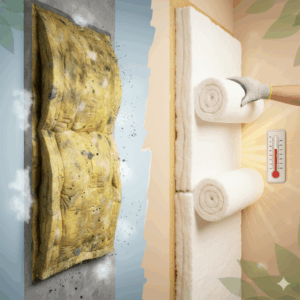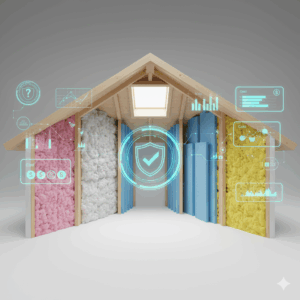When it comes to maintaining a comfortable and energy-efficient home, insulation is one of the most important factors. The effectiveness of insulation is measured by its R–Value, which indicates how well a material resists the flow of heat. A higher R–Value means stronger thermal resistance and greater energy savings.
Understanding the recommended R–Values for different areas of your home—such as the attic, walls, and floors—can help you make smarter decisions that keep energy bills low and comfort levels high.
What Are Home Insulation R–Values?
An R–Value is a standardized measurement used to describe the insulating power of a material. Every insulation product, whether fiberglass, cellulose, mineral wool, or spray foam, has its own R–Value rating. This number is calculated based on the material’s thickness, density, and thermal conductivity.
- Higher R–Values provide better resistance to heat transfer, meaning less energy is lost.
- Lower R–Values may still be useful in mild climates or areas where insulation needs are less demanding.
For homeowners, the challenge is not just choosing the right insulation type, but also ensuring the R–Value meets or exceeds the standard recommendations for their region.
Why R–Values Matter in Attics and Walls
Heat naturally moves from warm areas to cooler ones. This means in winter, warm air escapes through your roof and walls, while in summer, hot outdoor air seeps indoors. That’s why the insulation in both attics and walls is essential:
- Attic Insulation R–Values: Attics lose the most heat in a home because heat rises. Insulation here usually requires the highest R–Values to prevent energy loss.
- Wall Insulation R–Values: Walls cover a larger surface area and play a major role in stabilizing indoor temperatures. Even though their R–Values are lower than attics, wall insulation is critical for keeping drafts out and maintaining comfort.
Without the right insulation levels in these areas, HVAC systems work harder, utility bills rise, and indoor comfort suffers.
Standard Home Insulation R–Values by Region
The U.S. Department of Energy provides climate-based recommendations, since insulation needs vary depending on whether you live in a cold northern state, a hot southern region, or somewhere in between.
Here’s a breakdown of standard home insulation R–Values for different parts of a house:
| Home Area | Recommended R–Value (Range) | Why It Matters |
| Attic | R-30 to R-60 | Prevents major heat loss through the roof, especially in colder zones. |
| Walls (2×4 framing) | R-13 to R-15 | Provides baseline thermal protection in standard wall cavities. |
| Walls (2×6 framing) | R-19 to R-21 | Deeper cavities require higher R–Values for colder climates. |
| Floors | R-25 to R-30 | Essential when floors are above unheated garages or crawl spaces. |
| Crawl Spaces/Basement | R-11 to R-19 | Protects against moisture, cold drafts, and energy loss. |
These values should be seen as a minimum standard. Many homeowners choose higher R–Values for additional efficiency and long-term savings.
Choosing the Right Insulation for Your Home
It’s important to not only meet but also maximize the R–Values where possible. The type of insulation you choose—whether spray foam, fiberglass, or cellulose—also affects performance. If you’re unsure which option fits your house, resources like What Is the Best Type of Insulation for Your Home can provide clarity on the right material for your needs.
When Should You Upgrade Insulation?
Even the best insulation doesn’t last forever. Over time, it can settle, become damaged, or lose effectiveness. If you notice uneven temperatures, rising energy bills, or drafts, it may be time to consider an upgrade. Homeowners can benefit from exploring When To Replace Your Home Insulation to identify the right time for improvements.
Benefits of Meeting Recommended R–Values
Making sure your home meets recommended R–Values has many advantages, including:
- Lower energy costs
- Improved indoor comfort
- Reduced strain on heating and cooling systems
- Better moisture control
- Enhanced resale value
For a deeper understanding, guides like Top 5 Benefits of Upgrading Your Home’s Insulation provide valuable insights into long-term payoffs.
Frequently Asked Questions About Insulation R–Values
1. What is the best R–Value for attic insulation?
The recommended R–Value for attic insulation is generally between R-30 and R-60, depending on your climate zone. Colder regions need higher R–Values for maximum efficiency.
2. How do I know if my insulation meets the recommended R–Values?
You can measure the thickness of your existing insulation and compare it to standard charts for that material. A professional energy audit can also give you accurate readings and recommendations.
3. Do higher R–Values always mean better performance?
Yes, higher R–Values provide better resistance to heat flow, but the insulation type and installation quality also matter. Sometimes a well-installed lower R–Value material can perform better than poorly installed high R–Value insulation.
4. Can I add new insulation on top of old insulation?
In most cases, yes. As long as the old insulation is dry and free of mold or damage, new layers can be added on top to increase the total R–Value.
5. How much can upgrading my insulation save on energy bills?
On average, proper insulation can reduce heating and cooling costs by 15–25%. The exact savings depend on your current insulation levels, climate, and energy usage.
Final Thoughts
The recommended R–Values for home insulation are not just numbers—they represent the level of comfort, savings, and performance your home can achieve. By insulating properly in the attic, walls, floors, and basement, homeowners can ensure lasting protection against energy loss while enjoying lower utility bills.For expert guidance and professional insulation services, trust Guardian Home Energy to help you achieve the right R–Values tailored to your home.





